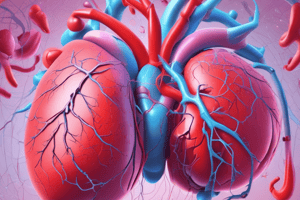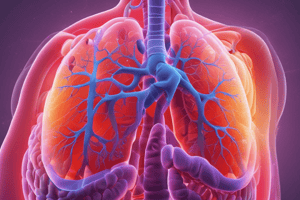Podcast
Questions and Answers
What is a significant contraindication for the use of prucalopride?
What is a significant contraindication for the use of prucalopride?
- Short term diarrhoea
- Chronic idiopathic constipation
- Severe inflammatory bowel condition (correct)
- Mild abdominal cramping
Which adverse effect is commonly associated with loperamide?
Which adverse effect is commonly associated with loperamide?
- Dehydration
- Intestinal obstruction
- Dizziness (correct)
- Severe abdominal cramping
What is the main mechanism of action for 5HT3 receptor antagonists?
What is the main mechanism of action for 5HT3 receptor antagonists?
- They enhance the action of serotonin on 5-HT3 receptors.
- They increase excitability of vagal afferent nerves.
- They stimulate the release of substance P in the CTZ.
- They block the action of serotonin on 5-HT3 receptors. (correct)
What mechanism do D2 receptor antagonists use to decrease vomiting?
What mechanism do D2 receptor antagonists use to decrease vomiting?
Which pharmacokinetic characteristic is true for Ondansetron?
Which pharmacokinetic characteristic is true for Ondansetron?
Which of the following pharmacokinetic properties applies to prucalopride?
Which of the following pharmacokinetic properties applies to prucalopride?
What is one of the unique features of domperidone compared to other D2 receptor antagonists?
What is one of the unique features of domperidone compared to other D2 receptor antagonists?
What adverse effect is commonly associated with NK-1 receptor antagonists?
What adverse effect is commonly associated with NK-1 receptor antagonists?
Which condition is an indication for the use of metoclopramide?
Which condition is an indication for the use of metoclopramide?
Which drug has the longest half-life among the mentioned antiemetics?
Which drug has the longest half-life among the mentioned antiemetics?
What common adverse effect is associated with the use of prochlorperazine?
What common adverse effect is associated with the use of prochlorperazine?
What is the action of corticosteroids in the context of nausea and vomiting?
What is the action of corticosteroids in the context of nausea and vomiting?
What is a common contraindication for the administration of corticosteroids?
What is a common contraindication for the administration of corticosteroids?
What is the primary action of loperamide in treating diarrhea?
What is the primary action of loperamide in treating diarrhea?
What pharmacokinetic characteristic applies to Aprepitant?
What pharmacokinetic characteristic applies to Aprepitant?
Which mechanism is NOT associated with the action of NK-1 receptor antagonists?
Which mechanism is NOT associated with the action of NK-1 receptor antagonists?
What is the primary mechanism by which Propranolol decreases portal blood flow?
What is the primary mechanism by which Propranolol decreases portal blood flow?
Which patient precautions are associated with the use of Terlipressin?
Which patient precautions are associated with the use of Terlipressin?
What is a common adverse effect of Octreotide?
What is a common adverse effect of Octreotide?
How does Terlipressin primarily affect variceal bleeding?
How does Terlipressin primarily affect variceal bleeding?
Which of the following is an indication for the use of Octreotide?
Which of the following is an indication for the use of Octreotide?
What is the half-life of Propranolol?
What is the half-life of Propranolol?
Which route of administration is used for Terlipressin?
Which route of administration is used for Terlipressin?
Which adverse effect is most likely associated with Propranolol?
Which adverse effect is most likely associated with Propranolol?
What is a common adverse effect associated with 5-aminosalicylates?
What is a common adverse effect associated with 5-aminosalicylates?
Which of the following mechanisms describes the action of 5-aminosalicylates?
Which of the following mechanisms describes the action of 5-aminosalicylates?
What is the primary indication for the use of immunosuppressants like azathioprine and mercaptopurine?
What is the primary indication for the use of immunosuppressants like azathioprine and mercaptopurine?
What could happen if mercaptopurine is administered alongside allopurinol?
What could happen if mercaptopurine is administered alongside allopurinol?
Which administration method is preferred for 5-aminosalicylates when treating ulcerative colitis?
Which administration method is preferred for 5-aminosalicylates when treating ulcerative colitis?
What is the primary pharmacological action of methotrexate?
What is the primary pharmacological action of methotrexate?
What adverse effect is specifically noted in azathioprine use?
What adverse effect is specifically noted in azathioprine use?
How is mesalazine primarily cleared from the body?
How is mesalazine primarily cleared from the body?
What is the primary mechanism of action for spironolactone?
What is the primary mechanism of action for spironolactone?
Which of the following describes the pharmacokinetics of spironolactone?
Which of the following describes the pharmacokinetics of spironolactone?
What role does albumin play in the treatment with terlipressin?
What role does albumin play in the treatment with terlipressin?
Which side effects are associated with spironolactone?
Which side effects are associated with spironolactone?
How does lactulose help in hepatic encephalopathy?
How does lactulose help in hepatic encephalopathy?
Flashcards are hidden until you start studying
Study Notes
Pharmacotherapeutics for Chronic Constipation
- Indicated for chronic idiopathic constipation when other laxatives are ineffective.
- Contraindicated in cases of intestinal obstruction and severe inflammatory bowel conditions.
- Administered orally.
- Adverse effects include abdominal cramping and diarrhea.
- Pharmacokinetics for Prucalopride:
- Metabolism: None (nil)
- Renal Excretion: 84%
- Half-life: 18-20 hours
Treatment of Diarrhea
- Antidiarrhoeals: Common drugs include Loperamide and diphenoxylate (with atropine).
- Pharmacodynamics:
- Opioid receptor agonists reduce cAMP, leading to decreased Ca²⁺ and inhibiting peristalsis.
- Indicated for short-term diarrhea relief, contraindicated in children.
- Administration is oral.
- Common adverse effects include abdominal pain, bloating, nausea, constipation, dizziness, and drowsiness.
- Pharmacokinetics for Loperamide:
- Metabolism: Extensive
- Renal Excretion: 1%
- Half-life: 10.8 hours
Treatment of Nausea and Vomiting
-
D² Receptor Antagonists: Includes Metoclopramide, Domperidone, Prochlorperazine.
-
Pharmacodynamics:
- Block dopamine action on D² receptors, decreasing vomiting center stimulation.
- Metoclopramide and Domperidone activate 5-HT₄ receptors, increasing gut motility.
- Prochlorperazine additionally blocks H₁ and M₁ receptors.
-
Indications: General nausea and vomiting, gastric stasis.
-
Contraindications: GI obstruction, Parkinson's disease.
-
Routes: Oral, IM, IV.
-
Adverse effects: Drowsiness, movement disorders, galactorrhea.
-
Pharmacokinetics for Metoclopramide:
- Metabolism: Yes
- Renal Excretion: Predominantly
- Half-life: 5-6 hours
-
5-HT₃ Receptor Antagonists: Ondansetron and Dolastron.
-
Blocks serotonin action in CTZ and vagal afferents, reducing vomiting.
-
Indicated for nausea, particularly post-chemotherapy.
-
Administered orally, IM, or IV.
-
Adverse effects: Constipation, headache, dizziness.
-
Pharmacokinetics for Ondansetron:
- Metabolism: Yes
- Renal Excretion: Yes
- Half-life: 3-4 hours
-
NK-1 Receptor Antagonists: Aprepitant and Fosaprepitant.
-
Mechanism involves blocking substance P to reduce vomiting.
-
Indicated primarily for chemotherapy-induced nausea.
-
Routes of administration: Oral, IV.
-
Adverse effects: Diarrhea, fatigue, headache.
-
Significant interactions with CYP3A4 and CYP2C9 enzymes.
-
Pharmacokinetics for Aprepitant:
- Metabolism: Yes
- Renal Excretion: None
- Half-life: 9-13 hours
-
Corticosteroids: Dexamethasone and Prednisolone.
-
Action mechanism involves unclear pathways affecting inflammation and serotonin.
-
Indications include prevention of nausea in postoperative situations and IBD.
-
Administration methods: Oral, suppository, IV.
-
Adverse effects: Fluid retention, hypertension, Cushing's syndrome.
5-Aminosalicylates for Inflammatory Bowel Disease
- Examples: Mesalazine and Olsalazine.
- Mechanism involves local anti-inflammatory effects in the colon.
- Indicated for ulcerative colitis and Crohn's with colonic involvement.
- Administration methods: Oral, rectal.
- Common adverse effects: Nausea, headache, diarrhea.
- Pharmacokinetics for Mesalazine:
- Metabolism: Mostly intestinal
- Renal Excretion: Predominantly
- Half-life: 40 minutes
Immunosuppressants
-
Examples: Azathioprine and Mercaptopurine.
-
Mechanism of action: Inhibition of B and T cells, anti-inflammatory properties.
-
Indicated for inflammatory bowel diseases.
-
Interactions with Allopurinol increase risk of toxicity from mercaptopurine.
-
Adverse effects include myelosuppression, infections, hair loss, gastrointestinal disturbances.
-
Pharmacokinetics for Azathioprine:
- Metabolism: Yes
- Renal Excretion: None
- Half-life: 5 hours
-
Methotrexate:
- Mechanism: Antifolate action inhibiting cell division.
- Indication: Refractory inflammatory bowel disease.
- Administration: Oral, SC, IM.
Management of Liver Disease Complications
-
Oesophageal Varices Treatment:
- Non-selective Beta Blockers: Propranolol, decreases portal blood flow, indicated for oesophageal varices.
- Pharmacokinetics for Propranolol:
- Metabolism: Yes
- Renal Excretion: Predominantly
- Half-life: 8 hours
-
Vasopressin Analogues: Terlipressin, activates V1 receptors for vasoconstriction.
-
Somatostatin Analogues: Octreotide inhibits hormone release, reducing portal blood flow.
Other Treatments
-
Ascites: Treated with Spironolactone, an aldosterone antagonist; indicated for excessive fluid accumulation.
-
Pharmacokinetics for Spironolactone:
- Metabolism: Extensively
- Renal Excretion: Primarily
- Half-life: 1.4 hours
-
Hepatic Encephalopathy: Managed with Lactulose, reducing ammonia absorption.
Studying That Suits You
Use AI to generate personalized quizzes and flashcards to suit your learning preferences.




